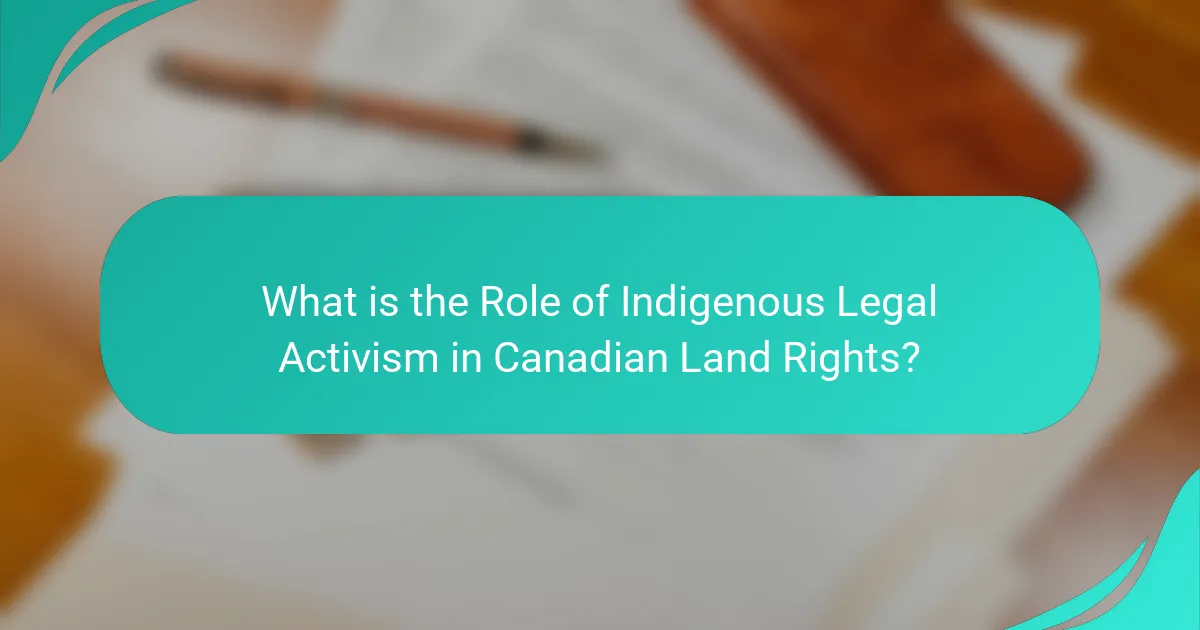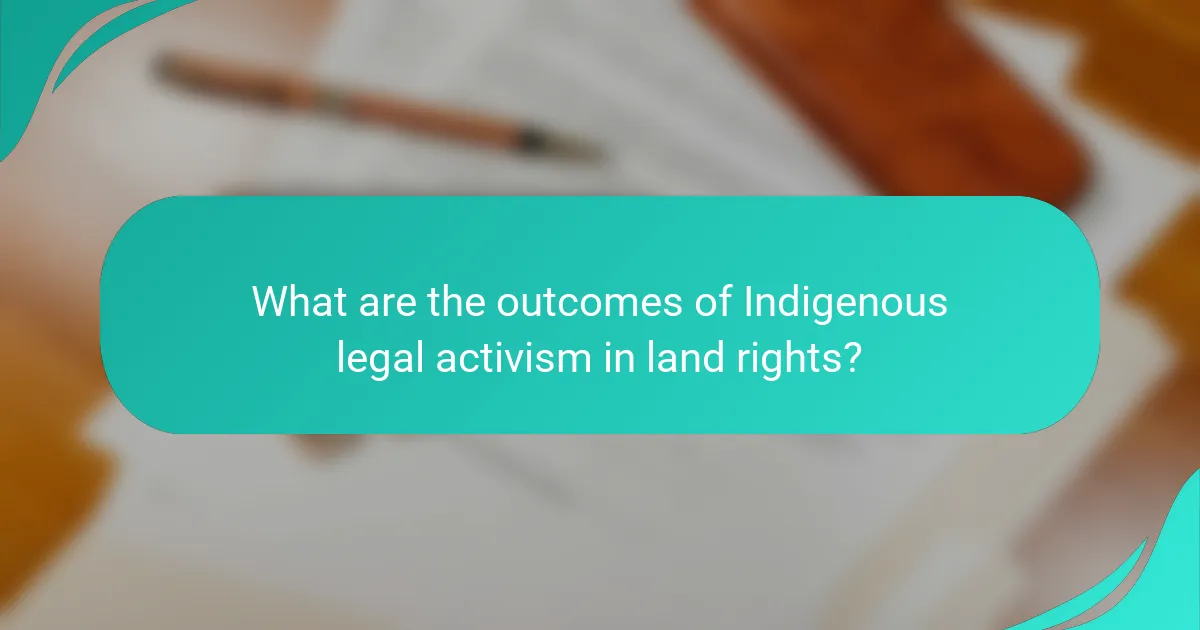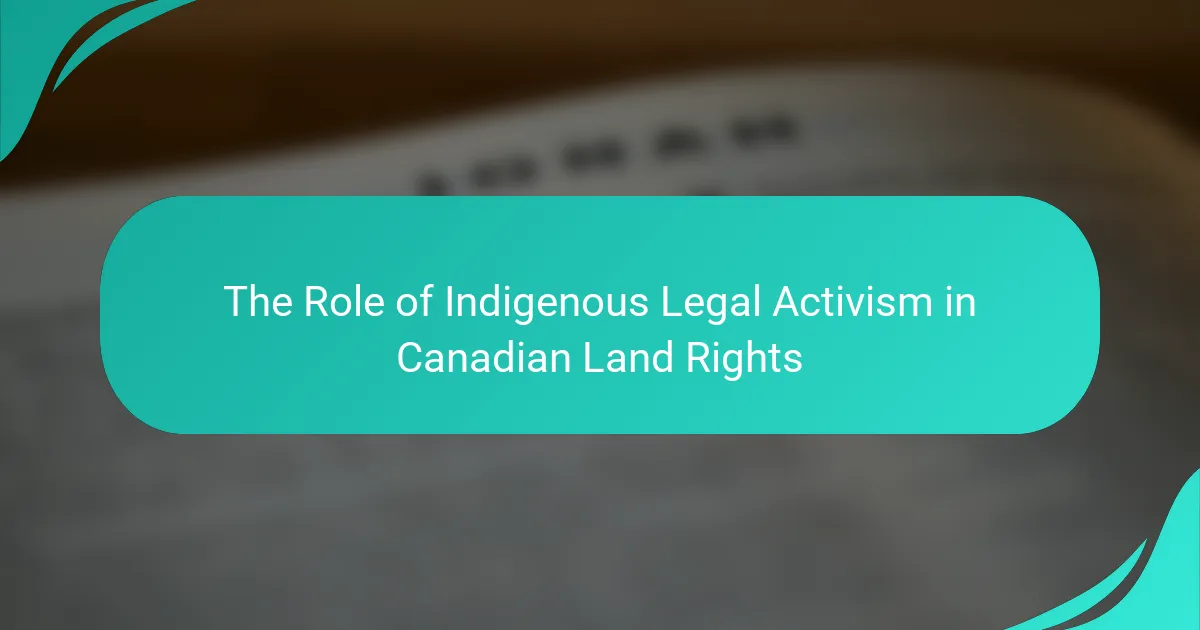
What is the Role of Indigenous Legal Activism in Canadian Land Rights?
Indigenous legal activism plays a crucial role in advancing land rights in Canada. It addresses historical injustices faced by Indigenous peoples regarding land ownership and usage. Activists utilize legal frameworks to assert treaty rights and challenge unlawful land dispossession. Notable cases, such as the Calder case in 1973, recognized Indigenous land claims, setting precedents for future activism. Additionally, organizations like the Assembly of First Nations advocate for legal reforms to protect Indigenous land rights. Legal activism also raises public awareness and fosters dialogue on Indigenous issues. Overall, it empowers Indigenous communities to reclaim their rights and influence land governance in Canada.
How has Indigenous legal activism evolved in Canada?
Indigenous legal activism in Canada has evolved significantly over the past several decades. Initially, Indigenous groups focused on treaty rights and land claims. Landmark cases, such as the Calder case in 1973, recognized Indigenous land rights. The 1990s saw the establishment of the Royal Commission on Aboriginal Peoples, which highlighted systemic issues. The Supreme Court’s decision in Delgamuukw in 1997 further affirmed Indigenous land rights. More recently, activism has expanded to include environmental protection and self-determination. Organizations like the Assembly of First Nations advocate for legal reforms. The evolution reflects a growing recognition of Indigenous rights within Canadian law. This shift has led to increased collaboration between Indigenous communities and governmental bodies.
What historical events have shaped Indigenous legal activism?
Indigenous legal activism has been shaped by several historical events. The Royal Proclamation of 1763 established guidelines for land transactions with Indigenous peoples. The establishment of treaties throughout the 19th century recognized Indigenous land rights. The 1969 White Paper proposed the elimination of Indigenous rights, prompting widespread opposition. The Calder case in 1973 recognized Indigenous land claims in Canada. The Constitution Act of 1982 included Section 35, which affirmed Indigenous rights. The Delgamuukw case in 1997 further defined land rights and title. The Truth and Reconciliation Commission, established in 2008, highlighted the need for justice and healing. Each of these events has significantly influenced the evolution of Indigenous legal activism in Canada.
What key legal milestones have been achieved by Indigenous activists?
Indigenous activists have achieved several key legal milestones in Canada. The Calder case in 1973 recognized Indigenous land rights, establishing a legal precedent. The Constitution Act of 1982 affirmed Indigenous rights, including land claims. The 1997 Delgamuukw decision acknowledged oral histories as valid evidence in land claims. The 2014 Tsilhqot’in decision granted the first declaration of Aboriginal title to a specific land area. The 2016 Supreme Court ruling in the Daniels case confirmed Métis and non-status Indians as “Indians” under the Constitution. These milestones collectively strengthened Indigenous legal claims and rights in Canada.
Why is Indigenous legal activism important for land rights?
Indigenous legal activism is crucial for land rights because it empowers Indigenous communities to assert their legal entitlements. This activism challenges historical injustices and promotes recognition of Indigenous sovereignty. Legal cases have established precedents that affirm land rights, such as the landmark Supreme Court case, Calder v. British Columbia (1973). This case recognized Indigenous land rights as existing prior to colonial claims. Furthermore, Indigenous legal activism fosters dialogue between governments and Indigenous peoples, leading to more equitable land use policies. It also raises public awareness about Indigenous issues, influencing policy changes and societal attitudes. Overall, this activism is essential for ensuring that Indigenous voices are heard in land rights discussions.
How does it impact Indigenous communities and their sovereignty?
Indigenous legal activism significantly impacts Indigenous communities and their sovereignty by empowering them to assert their rights. This activism often leads to legal recognition of land claims and self-governance. For example, the Supreme Court of Canada’s decision in the Calder case (1973) acknowledged Indigenous land rights, reinforcing their sovereignty. Legal victories can result in the return of traditional lands and resources. Additionally, activism fosters greater political engagement within Indigenous communities. It also raises awareness of Indigenous issues among the broader Canadian public. These outcomes strengthen the cultural identity and social cohesion of Indigenous peoples. Overall, legal activism is a crucial tool for advancing Indigenous sovereignty.
What role does it play in environmental protection and sustainability?
Indigenous legal activism plays a crucial role in environmental protection and sustainability. This activism often emphasizes the connection between land rights and ecological stewardship. Indigenous communities advocate for the recognition of their land rights, which leads to better management of natural resources. Their traditional knowledge contributes to sustainable practices that protect biodiversity. Legal actions by Indigenous groups have resulted in landmark court decisions that affirm their rights and responsibilities towards the environment. For example, the Supreme Court of Canada’s decision in the Tsilhqot’in case recognized Indigenous land title, promoting conservation efforts. Such activism ensures that Indigenous voices are included in environmental policy discussions. This inclusion fosters a more holistic approach to sustainability that benefits both the environment and Indigenous communities.
What challenges do Indigenous legal activists face in Canada?
Indigenous legal activists in Canada face numerous challenges. These include systemic discrimination within the legal system. Many Indigenous activists encounter barriers in accessing justice. Legal processes can be lengthy and costly, deterring participation. Additionally, there is often a lack of understanding of Indigenous rights among legal professionals. Activists may also face opposition from governmental and corporate entities. This can result in significant legal and financial risks. Furthermore, activists often struggle with limited resources and support. These challenges hinder their ability to advocate effectively for land rights.
How do systemic barriers affect their efforts?
Systemic barriers significantly hinder Indigenous legal activism in Canadian land rights. These barriers include historical injustices, discriminatory policies, and lack of access to legal resources. Indigenous communities often face challenges in asserting their rights due to bureaucratic obstacles. For example, the Indian Act imposes limitations on land ownership and governance. Additionally, systemic racism can lead to biased legal interpretations against Indigenous claims. Studies show that 60% of Indigenous land claims remain unresolved, illustrating the extent of these barriers. This persistent struggle undermines their efforts to achieve justice and recognition of land rights.
What legal obstacles hinder the progress of land rights claims?
Legal obstacles that hinder the progress of land rights claims include complex legal frameworks and inadequate recognition of Indigenous rights. Many land rights claims are subjected to lengthy legal processes. These processes often require extensive documentation and evidence of historical land use. Additionally, existing laws may not align with Indigenous perspectives on land ownership. Jurisdictional disputes between federal and provincial governments can further complicate claims. Limited access to legal resources also affects the ability of Indigenous groups to pursue their claims effectively. Furthermore, systemic biases within legal institutions may lead to unfavorable outcomes for Indigenous claimants. These factors collectively impede the timely resolution of land rights issues.
How do Indigenous legal activists collaborate with other organizations?
Indigenous legal activists collaborate with other organizations through strategic partnerships and coalitions. They often work with non-profit groups, academic institutions, and legal aid organizations. These collaborations enhance resources and expertise. Indigenous activists share knowledge about legal frameworks and cultural contexts. In turn, partner organizations provide support in research and advocacy. Joint initiatives may include litigation, policy development, and public awareness campaigns. For example, the Assembly of First Nations collaborates with environmental groups on land protection issues. Such partnerships amplify the voices of Indigenous communities in legal settings.
What partnerships have been formed to support land rights initiatives?
Partnerships formed to support land rights initiatives include collaborations between Indigenous communities, non-governmental organizations, and government bodies. These partnerships aim to strengthen advocacy for land rights and promote legal recognition. For instance, the Assembly of First Nations collaborates with environmental groups to address land protection. Additionally, legal aid organizations partner with Indigenous leaders to provide legal support in land claims. The United Nations has also facilitated partnerships to enhance Indigenous participation in policy-making. These collaborations have led to significant advancements in recognizing and protecting Indigenous land rights in Canada.
How do these collaborations enhance the effectiveness of activism?
Collaborations enhance the effectiveness of activism by uniting diverse resources and perspectives. They allow for a broader coalition of voices, increasing visibility for issues. Collaborations can mobilize larger audiences, leading to heightened awareness and support. For example, partnerships between Indigenous groups and environmental organizations amplify messages about land rights. This combined effort can lead to more impactful legal challenges. Research shows that coalitions often achieve greater policy changes than isolated efforts. Collaborations also foster knowledge sharing, strengthening strategies and tactics used in activism. Overall, collective action drives more significant change in land rights advocacy.

What strategies are used in Indigenous legal activism?
Indigenous legal activism employs various strategies to assert rights and protect land. These strategies include litigation, advocacy, and community mobilization. Litigation involves bringing cases to court to challenge unjust laws and policies. Advocacy focuses on raising awareness and influencing public policy through campaigns. Community mobilization engages Indigenous communities in grassroots efforts to assert their rights.
Additionally, coalition-building with non-Indigenous allies enhances the effectiveness of these strategies. Legal education empowers community members to understand their rights and navigate the legal system. Strategic use of international human rights frameworks also plays a role in Indigenous legal activism. These strategies collectively aim to reclaim land and assert sovereignty over Indigenous territories.
How do Indigenous activists utilize legal frameworks?
Indigenous activists utilize legal frameworks to assert and protect their rights. They engage in litigation to challenge governmental policies that infringe upon their land rights. Activists often rely on treaties and constitutional provisions to support their claims. For instance, the Constitution Act of 1982 recognizes Indigenous rights in Canada. Activists also participate in consultations mandated by law to ensure their voices are heard. They work with legal experts to navigate complex legal systems effectively. Court cases often set precedents that strengthen their legal position. Landmark cases like Delgamuukw v. British Columbia have affirmed Indigenous land rights. These actions demonstrate the strategic use of legal frameworks to achieve justice and recognition.
What types of legal actions are commonly pursued?
Common legal actions pursued include land claims, treaty rights litigation, and environmental assessments. Indigenous groups often seek recognition of their land rights through court cases. These cases can challenge government decisions affecting traditional territories. Legal actions may also involve negotiations for land restitution. Additionally, Indigenous activists may pursue actions related to resource management. They often focus on protecting natural resources from exploitation. Legal advocacy is crucial for asserting sovereignty and rights. These actions are supported by historical treaties and legal precedents.
How do activists engage in public awareness campaigns?
Activists engage in public awareness campaigns by utilizing various strategies. They organize community events to educate the public about land rights issues. Activists leverage social media platforms to reach a broader audience. They create informative content such as articles, videos, and infographics. Collaborations with local organizations enhance their outreach efforts. Petition drives and letter-writing campaigns mobilize community support. Public demonstrations and rallies draw attention to specific causes. Research shows that these methods effectively raise awareness and influence public opinion on Indigenous land rights.
What role does storytelling play in Indigenous legal activism?
Storytelling plays a crucial role in Indigenous legal activism. It serves as a means of preserving cultural identity and history. Indigenous narratives are used to articulate land rights and legal claims. These stories provide context and depth to legal arguments. They convey the spiritual and emotional connections to the land. Courts have recognized storytelling as a valid form of evidence. For instance, the Supreme Court of Canada has acknowledged the importance of oral histories in cases like Delgamuukw v. British Columbia. This integration of storytelling enhances the understanding of Indigenous perspectives in legal contexts. Overall, storytelling is essential for advocating Indigenous rights and fostering legal recognition.
How do narratives influence public perception and policy?
Narratives significantly influence public perception and policy by shaping the way issues are understood. They frame the context in which information is presented. For example, Indigenous narratives about land rights emphasize historical injustices and cultural connections. This framing can alter public sentiment, leading to increased support for Indigenous claims. Research shows that storytelling can evoke empathy and change attitudes. A study by the University of Alberta found that narratives about Indigenous experiences led to greater public awareness of land rights issues. Consequently, these shifts in perception can prompt policymakers to reconsider existing laws and regulations. Thus, narratives serve as powerful tools for advocacy and change in the realm of public policy.
What traditional practices are incorporated into activism efforts?
Traditional practices incorporated into activism efforts include storytelling, ceremonies, and community gatherings. Storytelling serves to pass down knowledge and cultural values. Ceremonies often mark significant events and foster community solidarity. Community gatherings create spaces for collective decision-making and action. These practices strengthen cultural identity and promote unity among activists. They also provide historical context, linking current struggles to ancestral teachings. For example, the use of traditional songs and dances can mobilize support and raise awareness. Such practices are vital in Indigenous legal activism, emphasizing the connection between land, culture, and rights.

What are the outcomes of Indigenous legal activism in land rights?
Indigenous legal activism in land rights has led to significant outcomes. It has resulted in the recognition of land claims and rights in Canada. Landmark cases, such as the Calder case in 1973, affirmed Indigenous land rights. The Supreme Court’s decision in the Delgamuukw case in 1997 further defined Indigenous title. These rulings have influenced policies and negotiations between Indigenous groups and the government. Activism has also increased public awareness of Indigenous issues. The outcomes include improved legal frameworks for land rights. Additionally, there is a growing movement for reconciliation and respect for Indigenous sovereignty.
What successes have been achieved through legal activism?
Legal activism has led to significant successes in advancing Indigenous land rights in Canada. Notable achievements include the Calder case in 1973, where the Supreme Court recognized Indigenous land rights for the first time. This landmark decision acknowledged that Indigenous peoples have rights to their traditional lands. Another success is the 2014 Tsilhqot’in Nation v. British Columbia ruling, which granted the Tsilhqot’in Nation title to over 1,700 square kilometers of land. This ruling affirmed the legal recognition of Indigenous land title and set a precedent for future claims. Additionally, the 2016 Supreme Court decision in the case of the Mikisew Cree First Nation reinforced the duty of the Crown to consult with Indigenous groups regarding resource development. These legal victories demonstrate the effectiveness of legal activism in securing Indigenous rights and recognition in Canada.
How have land rights been restored or recognized?
Land rights have been restored or recognized through legal frameworks and activism. Indigenous groups have utilized treaties and court cases to assert their land claims. The landmark case of Delgamuukw v. British Columbia in 1997 recognized oral histories as valid evidence of land rights. The Supreme Court of Canada affirmed Aboriginal title in the Tsilhqot’in Nation v. British Columbia case in 2014. These rulings have led to negotiations for land return and co-management agreements. Additionally, the United Nations Declaration on the Rights of Indigenous Peoples has influenced Canadian policy. Activism has mobilized communities to demand recognition and restoration of land rights.
What positive changes have occurred in Indigenous governance?
Indigenous governance has seen significant positive changes in recent years. Many Indigenous communities have gained greater autonomy and self-determination. This shift is evidenced by the implementation of self-government agreements in various regions. For instance, the Nisga’a Treaty in British Columbia established a framework for self-governance in 1998. Additionally, the recognition of Indigenous rights has been strengthened through landmark court decisions. The Supreme Court of Canada’s ruling in the Calder case affirmed Indigenous land rights in 1973. Furthermore, increased participation in political processes has empowered Indigenous leaders. Many communities are now actively involved in environmental stewardship and resource management. These changes reflect a growing acknowledgment of Indigenous governance systems’ legitimacy and importance.
How does Indigenous legal activism influence Canadian law and policy?
Indigenous legal activism significantly influences Canadian law and policy by advocating for the recognition of Indigenous rights. This activism has led to landmark legal decisions that affirm Indigenous land claims and self-governance. For example, the Supreme Court of Canada’s ruling in the 2014 Tsilhqot’in Nation case recognized Indigenous land title, setting a precedent for future claims. Additionally, Indigenous activism drives policy changes that promote consultation and accommodation in resource development. The United Nations Declaration on the Rights of Indigenous Peoples also reflects the impact of this activism, urging Canada to align its laws with international standards. Overall, Indigenous legal activism is a catalyst for legal reforms that enhance Indigenous rights and sovereignty in Canada.
What legislative changes have resulted from activism efforts?
Legislative changes resulting from Indigenous activism efforts in Canada include the recognition of land rights and self-governance. The Constitution Act of 1982 included Section 35, which acknowledged Indigenous rights. This was influenced by activism, particularly the Calder case in 1973, which affirmed Indigenous land claims. The Native Claims Settlement Act in 1975 was also a direct result of activism, leading to land settlements in the Yukon. Additionally, the creation of the Nunavut Territory in 1999 stemmed from negotiations driven by Indigenous groups. These changes reflect the impact of sustained activism on Canadian law and policies regarding Indigenous rights.
How are government policies shifting in response to Indigenous claims?
Government policies are increasingly shifting towards recognizing and addressing Indigenous claims. This change is driven by legal precedents and activism from Indigenous groups. For example, the Supreme Court of Canada has ruled in favor of Indigenous land rights in several landmark cases. These rulings have prompted governments to engage in negotiations for land treaties and self-governance agreements. Additionally, there is a growing emphasis on incorporating Indigenous perspectives into environmental assessments. Federal and provincial governments are also allocating resources to support Indigenous communities in land claim processes. This shift reflects a broader societal recognition of Indigenous rights and sovereignty.
What can be learned from Indigenous legal activism for future movements?
Indigenous legal activism teaches future movements the importance of legal frameworks in advocating for rights. It demonstrates how legal action can challenge systemic injustices. Historical cases, such as the Calder case in 1973, show successful claims to land rights. These cases highlight the effectiveness of combining legal strategies with grassroots mobilization. Additionally, Indigenous activism emphasizes the need for cultural knowledge in legal arguments. This approach fosters community engagement and strengthens claims. Future movements can also learn the value of coalition-building across diverse groups. Collaborating with allies amplifies voices and resources. Overall, Indigenous legal activism provides a blueprint for integrating legal advocacy with community empowerment.
What best practices can be adopted by other social justice movements?
Best practices that can be adopted by other social justice movements include building coalitions and fostering alliances. Collaborating with diverse groups enhances collective strength and reach. Engaging in community education empowers individuals with knowledge about their rights. Utilizing legal frameworks effectively can protect and advance social justice causes. Incorporating storytelling humanizes issues and resonates with broader audiences. Leveraging social media amplifies messages and mobilizes support quickly. Emphasizing intersectionality ensures that various identities and experiences are represented. Lastly, maintaining transparency and accountability builds trust within the movement and with the public.
How can lessons from Indigenous activism inform broader land rights discussions?
Lessons from Indigenous activism can significantly inform broader land rights discussions by highlighting the importance of recognizing historical injustices. Indigenous activism emphasizes the need for land acknowledgment and the restoration of rights that have been historically denied. This activism showcases successful legal strategies that can be adapted to other contexts, such as treaty rights and land claims.
Furthermore, the emphasis on community involvement and consensus in Indigenous activism can guide inclusive decision-making processes. Evidence of the effectiveness of these strategies is seen in landmark cases like the Calder case in Canada, which recognized Indigenous land rights. This case has set a precedent for recognizing Indigenous sovereignty and can inspire similar movements globally.
Additionally, Indigenous activism teaches the importance of environmental stewardship and sustainable land use, aligning land rights with ecological preservation. By integrating these lessons, broader land rights discussions can become more equitable and just, ultimately leading to more effective policies that respect the rights of all communities.
The main entity of this article is Indigenous legal activism in Canada, which plays a vital role in advancing land rights for Indigenous peoples. The article outlines the evolution of this activism, highlighting key historical events and legal milestones that have shaped the landscape of Indigenous land claims. It discusses the importance of legal frameworks, the challenges faced by activists, and the impact of their efforts on Indigenous communities and governance. Additionally, the article explores the collaboration between Indigenous activists and other organizations, the strategies employed in activism, and the outcomes achieved in terms of legal recognition and policy changes. Overall, it emphasizes the significance of Indigenous legal activism in reclaiming land rights and promoting environmental sustainability.




